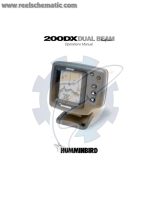
Example 2: Often-used function
If you think you’ll be using zoom often, you can go to the zoom function, let the
instructions disappear, and then activate the zoom when you need it by simply pressing On/Off.
Also, certain settings are stored in memory and are retained when the power is turned of and
back on again – sensitivity, bottom alarm depth, bottom alarm on/off, screen color, and depth
units.
The following describes the functions and how to use them, in order of appearance after you turn
the unit on.
1. Sensitivity
Automatic setting: on, “O” or previous setting
As conditions change, the computer will automatically increase or decrease the sensitivity
setting. You can manually increase or decrease the automatic setting from a range of “+5” to
“-5”. This level will maintain itself automatically for as long as you have the unit on, as a result
of the CVR’s Sensitivity Bias feature. For example, if you set the sensitivity at “+2”, the
sensitivity will remain 2 settings higher than the normal automatic settings until you change it
again.
2. Depth Range
Automatic setting: on
The CVR 1000 automatically finds the bottom, and then sets and displays the ideal depth
range when you turn the unit on. If you choose to leave the auto range change on, the depth
ranges will change automatically. Or, you can turn the auto change off, allowing you to
change the depth range manually. With auto change off, you can also select an additional
depth range of 360 feet. Depending on conditions and installation, this additional depth range
may exceed the CVR 1000’s capabilities.
3. Bottom Alarm
Automatic setting: off
Use the On/Off button to activate the alarm, and the arrow keys to adjust the depth at which
the alarm will sound. You’ll hear a continuous chirping sound whe the bottom is within the
area that you’ve defined with the alarm cursor. This is a great feature to use to alert you to
shallow water or to maintain your position over structure.
4. Fish Alarm
Automatic setting: off
The fish alarm is easily activated by pressing the On/Off button. This 6-level alarm can be set
to sound for all fish, or to ignore weaker signals and alarm only for stronger signals, such as
those from larger fish. This is based on the order of colors on the color bar. For example, you
can set the alarm for signals that are purple or stronger, ignoring the weaker light blue and
green signals. The arrow keys are used to set the fish alarm levels.
You can also adjust the volumes of the fish alarm by using the On/Off button. When you turn
the alarm on, you’ll see “ON LOUD” displayed in the instructions. Pressing On/Off once again
gives you the “ON SOFT” setting. Pressing the button a third time turns the fish alarm off.
5. Zoom
Automatic setting: off
When zoom is activated by pressing On/Off, it creates a “window” of expanded, up-close
information. The cursor at the right of the screen can be moved up or down with the arrow
buttons. When the zoom is activated, the “window” marked by the cursor is expanded to the
full size of the display. The exact depth of the upper and lower limits of the zoom window are



















